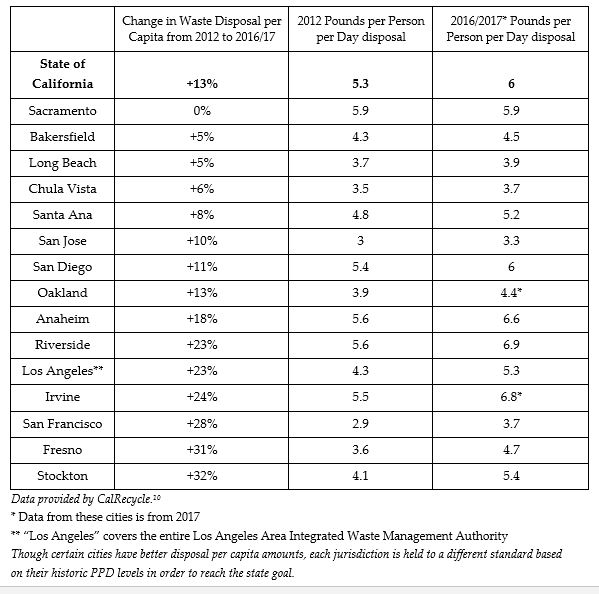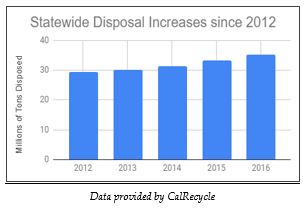The State of Waste in California
Californians throw away 6 pounds of trash every day, equivalent to almost 2200 pounds every year, roughly the weight of a subcompact car. These individual results more than double the state’s 2020 goal of 2.7 pounds per person per day (PPD).
Downloads
Californians throw away 6 pounds of trash every day, equivalent to almost 2200 pounds every year, roughly the weight of a subcompact car. These individual results more than double the state’s 2020 goal of 2.7 pounds per person per day (PPD). The California Department of Resources Recycling and Recovery (CalRecycle) measures individual disposal in terms of PPD because it considers the both recycling rate and overall disposal (recycling and compost are not counted as trash). Why? The goal is waste reduction, and an increased recycling rate doesn’t guarantee less trash if residents consume more stuff, potentially increasing trash as well as recycled and composted content.
Unfortunately, these things are getting worse, not better. Since 2012, disposal per resident has increased from 5.3 to 6 pounds while the recycling rate has decreased from 50 percent to the current 44 percent. Although California’s recycling rate remains above the national average 34.7 percent, results are well below the state’s 2020 goal of 75 percent.
Every single major city in California has failed to improve their reduction of waste since 2012. The following table demonstrates how these cities stack up and how much their disposal per capita has changed since 2012.
Note: Statewide and city disposal rates are held to different standards under California laws AB 341 and AB 949, respectively. The statewide rate does not include beneficial reuse or other disposal-related activities at landfills, which may be included in diversion rates for cities under AB 939. If cities adhered to the standards of AB341, their disposal would likely be higher, given the addition of disposal-related activities.

Reducing contamination in the waste stream is a simple action for residents that can have major impacts. A study done by CalRecycle in 2014 found that 70 percent of material taken to disposal facilities could have been recovered through a recycling or composting program–equivalent to roughly 21.8 million tons of waste, the weight of nearly 52 golden gate bridges. As Californians throw away millions more tons of trash each year (see below graph), the impact of this recovery loss becomes even greater.

It’s time for California to reverse the current trend and refocus on reaching its 2020 goals. To do so, the state will have to contend with the effects of recent changes in international trade. For decades, the United States sent millions of tons of scrap material to China to be recycled. This past year, China effectively stopped accepting our refuse, claiming it was too contaminated and unsellable for recycling. The United States was unprepared for this change in policy. Without China as an export option, recyclables have been piling up in facilities throughout California. The disruption increased service costs, decreased revenue, and in some cases led recycling collectors to limit their services–Sacramento stopped collecting mixed plastics in July.
As the saying goes, change brings opportunity. Already, recycling in California brings economic benefits in the form of over 85,000 jobs, 5,300 businesses, and $19 billion in taxable income, sales, new products, and services. In the wake of China’s policy changes, California has an opportunity to expand its recycling economy through better collection, sorting, and developing end-market solutions previously provided by China.